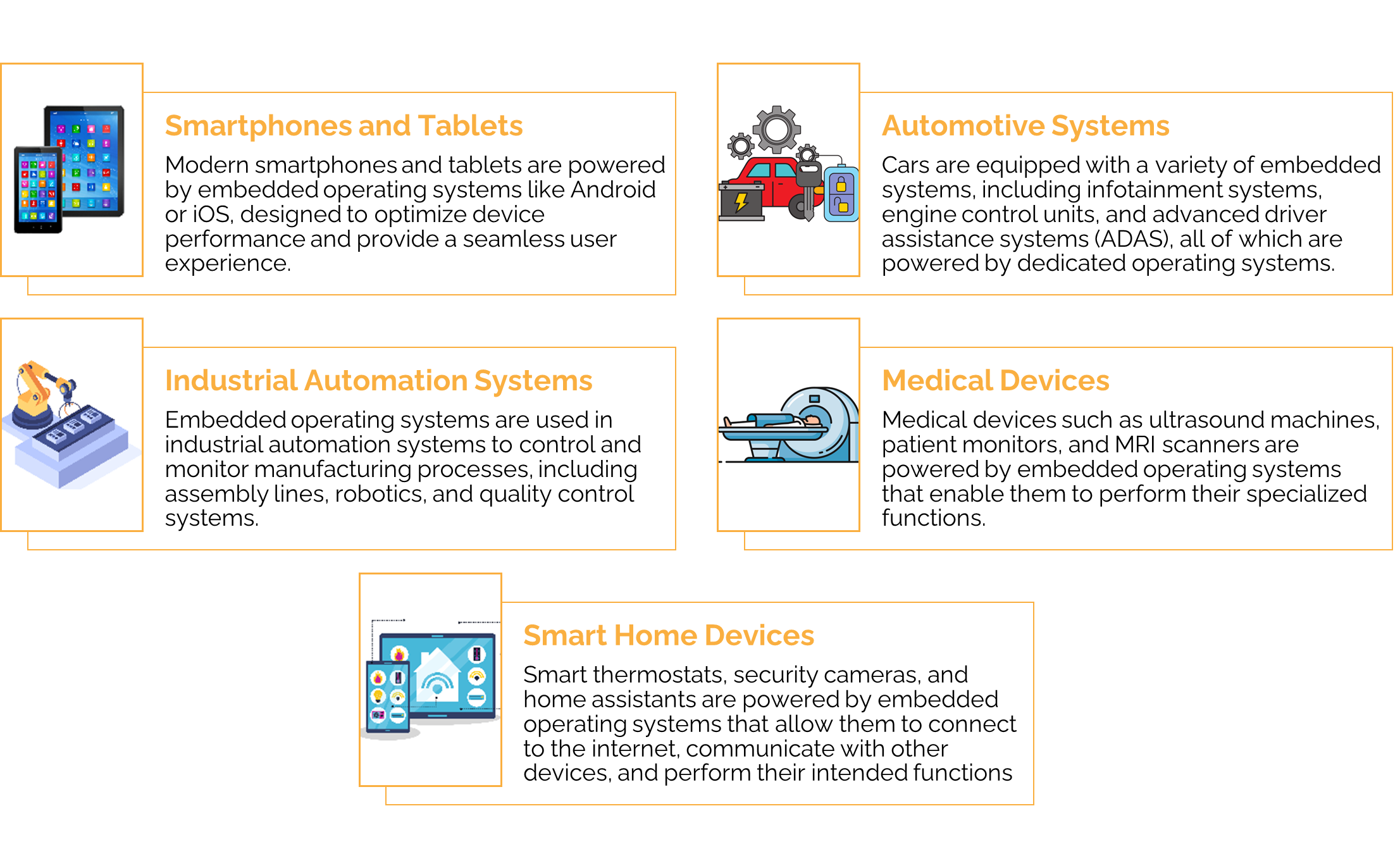Embedded Operating System
In the ever-evolving world of technology, embedded operating systems stand as the unsung heroes behind the smooth operation of our smartphones, digital cameras, and industrial control systems. These compact and efficient systems serve as the backbone, offering optimized performance and real-time capabilities for a wide range of embedded devices.
Embedded operating systems are the brains behind many devices we use today, dictating their performance and capabilities. They help to optimize graphics processing, manage hardware resources effectively, and ensure swift response times for various operations. Interestingly, embedded operating systems are not new, as they have been around since the 1960s. The Apollo Guidance Computer, which powered both the Apollo Lunar Module (ALM) and Command Module (CM), was one of the first examples of an embedded operating system. The AGC provided navigation, guidance, and spacecraft control using advanced computation and electronic interfaces. Today, modern embedded operating systems like Linux and Android continue to revolutionize the technology landscape, enabling devices to perform at higher levels and enhancing user experiences. Thanks to the development in the technology of microcontrollers from 8-bit to 16-bit and then 32-bit, embedded computer systems have gone a long way ever since; also, the progress is far from over. Operating systems have become essential for adequately managing embedded software because of the growing sophistication of embedded computer systems.
Definition of the Embedded Operating Systems
An embedded system is a software and hardware combination created for a particular purpose. Additionally, embedded systems may operate as part of a more extensive system. The systems may be programmable or may only perform specific functions. An embedded system may be found in industrial machinery, consumer devices, agricultural and processing sector equipment, vehicles, medical devices, cameras, digital watches, home appliances, aircraft, vending machines, toys, and mobile devices. A small-scale computer or embedded system with few functionalities is known as an embedded operating system. It is made to perform one or more of the functionalities of an electronic final product. Similar to how a desktop computer needs an operating system such as Windows, Linux, or Mac OS to perform simple applications, embedded systems need an operating system to enable and speed up their functionality.
For instance, every mobile phone has an embedded operating system like iOS or Android that launches when the device is turned on. With the OS, developers could integrate an application over every smartphone with various hardware. In certain instances, the embedded operating system is also called a real-time operating system (RTOS). Thanks to it, it can fill in all the existing gaps and create a cohesive app, especially for the OS.
How Does an Embedded System Work?
Small processors integrated into mechanical or electrical appliances are low-cost and power efficient. The word "embedded" refers to the fact that embedded systems always operate as a component of an entire device. They typically include a CPU, a power source, memory, and communication interfaces. Embedded systems employ communication ports to send data via a communication protocol between the CPU and peripheral devices, which are frequently other embedded systems. With the aid of simple memory-stored software, the processor interprets this data. Typically, the software is customized for the purpose the embedded system provides.
Embedded systems frequently operate in real-time situations and interact with the hardware using an RTOS (real-time operating system). Designers have increasingly determined that near-real-time techniques are appropriate at greater levels of chip capacity and that the jobs are tolerant of minor fluctuations in reaction time. In these situations, reduced-feature Linux operating systems are frequently used. However, other operating systems, such as Embedded Java and Windows IoT, have also been reduced for use on embedded devices. A microcontroller or microprocessor might be the processor. Microcontrollers are merely microprocessors with built-in memory and external ports. Memory and peripherals are not built into microprocessors' chips but are used in separate integrated circuits. Both can be employed; however, because microprocessors are less integrated than microcontrollers, they often need additional support circuitry. A system on a chip (SoC) is a standard solution. On a single chip, SoCs house several processors and interfaces. For embedded systems with significant volume, they are frequently employed. Application-specific integrated circuits (ASIC) and field-programmable gate arrays (FPGA) are examples of SoCs.
Common Uses of Embedded Systems
1. Parking metering
The embedded operating system is necessary for smart municipal parking meters to manage user input, track time, and collect fees. Depending on the design, these devices can have a variety of functionalities built in. For instance, some demand the vehicle to provide the parking spot or car license, while others employ sensors to monitor the arrival and exit of vehicles. A user interface gives the driver options, such as specifying the estimated return time and adjusting payment.
2. Car navigation system
A compact computer with a touch interface that the driver may use to navigate through menus for GPS and route planning, play audio and radio, monitoring systems, and hands-free calls, monitoring fuel levels and pressure in tire make up the automobile navigation system. These systems are significantly more complicated in connected cars since they include "V2X" or vehicle-to-anything communications technologies. All these functions are performed by the computer, which also improves the driving experience.
3. Medical equipment
Medical equipment with embedded operating systems monitors bio constants automatically, delivers drugs, and notifies personnel when the bio constants exceed or fall below the threshold value. As a result, medical technology may assist physicians in treating patients, keeping an eye on their health, and even saving their lives.
4. Navigation system of an airplane
The navigation system aboard a plane is a prime illustration of a real-time operating system. An aircraft's primary computer is linked to most control systems, including the safety, pressure, wing, and engine controls. It is, therefore, mainly made to function within a plane and assist with tasks like emergency, take-off, and landing.
Difference Between Embedded OS & RTOS
RTOS (real-time operating system) is often an OS with fewer features that enables multi-threaded programs by processing outputs within certain time limits and behaving predictably. These programs must be performed precisely when predicted to preserve the system's functionality since they are time-sensitive. The rigorous resource management and scheduling offered by RTOS fulfill application requirements and guarantee that time-sensitive activities are completed by their due date. Additionally, there are two sorts of RTOSs: soft and hard real-time operating systems. The main distinction is that the hard RTOS must consistently complete a given task in a predetermined amount of time, such as X milliseconds.
An embedded operating system subset includes RTOS. So, does all RTOS constitute embedded operating systems? Not all embedded operating systems are RTOSs. The temporal significance of the system is where RTOS and Embedded OS solutions diverge most. A non-critical system may be an in-flight entertainment system, which each passenger can use to view movies, play games, or catch up on TV series while in the air. There is no set amount of time that the film or television shows may play once the passenger switches on the device. On the other hand, an airplane's navigation system, which oversees take-off, landing, and several other activities, must operate quickly. A real-time component is necessary to complete a task rapidly. Unexpected delays will never be an option in such a system. It is crucial to assess these criteria while choosing real-time operating systems for embedded computers.
Some Examples of Embedded OS
Embedded operating systems are used in a wide range of products that require a dedicated computing system to perform specific tasks. Some of the most common examples of products that use embedded operating systems include:
In conclusion, embedded operating systems have been around for decades, powering a wide range of devices we use daily. They are designed to optimize graphics processing, manage hardware resources effectively, and ensure swift response times for various operations. The functioning of a device is determined by the embedded operating system, which is effectively the mind of an integrated computer system. The use of embedded operating systems has become increasingly important due to the growing sophistication of embedded computer systems. Using embedded operating systems has revolutionized the technology landscape, enabling devices to perform at higher levels and enhancing user experiences. With the continuous progress in microcontrollers and the development of new technologies, the future of embedded operating systems is promising. It will continue to shape the devices we use in our everyday lives.
*Disclaimer: This report is based on information that is publicly available and is considered to be reliable. However, Lumenci cannot be held responsible for the accuracy or reliability of this data.
*Disclaimer: This report is based on information that is publicly available and is considered to be reliable. However, Lumenci cannot be held responsible for the accuracy or reliability of this data.
Author
Shashwat Chatterjee
Associate Consultant at Lumenci
Shashwat is a professional with a master's degree in Electronics and Communication from MNIT Jaipur. Currently, he is employed at Lumenci, where he is involved in various service lines related to intellectual property, such as infringement analysis, claim chart review, and other patent monetization and litigation projects. Alongside his work, Shashwat has developed a strong passion for Blockchain Technology.


